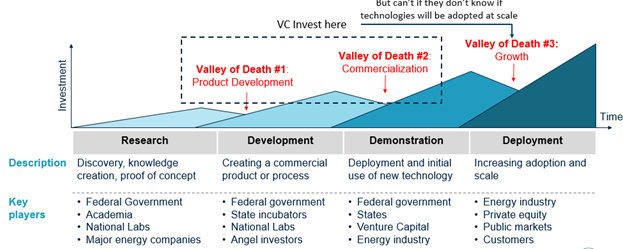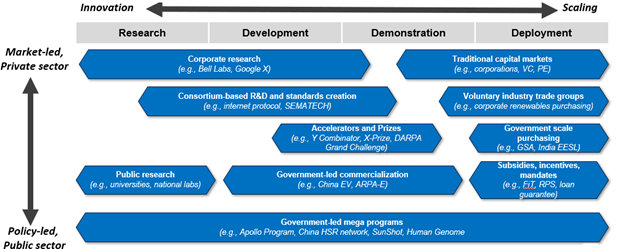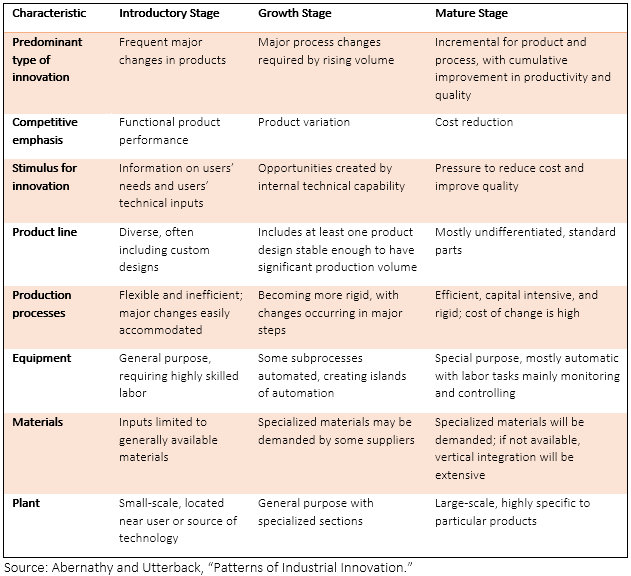Technology innovation is often described as a linear process that starts with basic scientific research, proceeds through applied research, then development followed by demonstration and deployment as commercial products and processes. While this depiction is convenient, the reality is usually much more complex and iterative, with interplay among scientists, engineers, design professionals, marketing experts, users and customers, providers of complementary products and services, and others.
While many important energy technology advances have emerged from scientific research, others have arisen from customer and user insights, shop-floor experimentation, and other sources. Policies and regulations can also propel, impede, or channel technology development. Scientific and technical capabilities (technology push) and signals from the marketplace (market pull) represent the dual drivers of technology innovation, with both elements typically needing to be present.
Linkages and Success Drivers in Technology Innovation
The following points, drawn from a U.S. congressional report on innovation and commercialization, summarize major findings concerning the innovation process and system.[1]
Linkages Between Science, Technology, and Innovation
- The linear model of innovation—which implies that innovation proceeds sequentially from new scientific discoveries to new products, processes, and services—is limited in its descriptive and predictive powers. Innovation can assume many forms, including incremental improvements to existing products, applications of existing technology to new markets, and uses of new technology to serve an existing market. Though typically less revolutionary, these other forms of innovation are equally important to the U.S. economy and national well-being in terms of the performance improvements and cost reductions they produce.
- Science plays a critical role in innovation, but is not necessarily the driver of new products, processes, and services. New ideas for innovation can stem from many sources, including new manufacturing capabilities and recognition of new market needs, as well as scientific and technological discoveries. Innovation and commercialization require considerable feedback between science, engineering, product development, manufacturing, and marketing.
- The nature of innovation changes over time as product lines and industries mature. Whereas the early stages of an industry are characterized by radical innovations that create wholly new products, processes, or services and are often based on new science or technology, later stages are characterized by incremental innovation, which builds upon existing products, processes, and services and derives more from advances in manufacturing capability, product design, and component technologies.
- Successful commercialization is not simply a matter of developing technology first or getting to market first. While being first can bestow advantages on an innovating firm, firms must create and maintain a competitive advantage in the marketplace by staking out and protecting a proprietary position through patents, trade secrets, or market barriers, and by securing the complementary assets and skills needed to ensure proper manufacturing, marketing, and support.
Elements of Innovation Systems
- Successful commercialization requires an environment conducive to innovation and requisite industrial infrastructure. Institutional arrangements are needed to establish standards, regulations, and rules governing areas such as intellectual property and antitrust. Human, financial, and scientific resources are required as the basic inputs to the innovation process. Complementary assets—both related technologies and necessary skills in manufacturing and distribution—are often needed to ensure that companies can succeed in the marketplace. Potential customers frequently need additional assurances and warranties that new products, processes, and services will work as advertised. Policymakers cannot assume that investments in the science base alone will ensure economic success.
- Government and industry both play a role in establishing the environment and infrastructure necessary to support innovation and commercialization. Government influences innovation and commercialization through tax and financial policies and through the patent system. Furthermore, in fulfilling its public missions, government affects technology development and market acceptance through procurement, regulations to protect human health and the environment, development of technologies, and funding of basic research. The unintentional effects of government actions on the innovation and commercialization process must be understood in order to maintain a healthy economy.
Commercialization and the Valleys of Death
As a technology advances from an early idea through proof-of-concept, then on to a commercial product or process deployed at scale, there is a progression of activities typically requiring growing scales of investment. Sometimes a large corporation or major government initiative can support technology development throughout all these stages, but typically a varying cast of investors and supporting entities channel technologies from early research through development and demonstration and then into commercial production.
Figure 1 provides a schematic illustration of stages of the commercialization process, key players, and the three “Valleys of Death” that technology developers may encounter and would need to bridge to achieve success.
Figure 1. Handoffs in commercialization create the well-known Valleys of Death

Source: Rocky Mountain Institute (used with permission)
For entrepreneurial start-ups, angel and venture capital (VC) investors can help move a technology from the laboratory to an early commercial prototype to bridge the first Valley of Death. VC investors can also fund further development to cross the second Valley of Death that stands prior to initial deployment as a commercial-scale demonstration. However, before investing at that stage, VC investors need to perceive an exit path to cash out of a technology by handing it off to private equity, public markets, or an incumbent industry buyer that can take the technology to a commercially deployable scale.
Figure 2 illustrates various private and public sector institutions and activities that can help sustain a promising technology through the commercialization process and bridge the Valleys of Death.
Figure 2. Piecemeal interventions can address individual Valleys of Death

Source: Rocky Mountain Institute (used with permission)
State and federal government can, at times, provide support through funding channels, technical and business assistance, and incubator services. State Energy Offices can play important roles to support clean energy technology innovation and commercialization in their states, ranging from helping develop Governor-led innovation initiatives and policies and coordinating state agencies and resources to administering innovation-supportive policies and programs.
Characteristics of Innovation in Different Phases of Industrial Development
The focus and characteristics of innovation tend to vary with the maturity of a product or technology. (See Table 1.) During the early stages of a major technology, there are often significantly different approaches that compete on functional performance. Historic examples include early automobiles where steam, electric and gasoline powered models competed, and early personal computing, where companies offered products with differing, incompatible architectures and operating systems. Typically, as the technology enters the growth phase, industry will settle on a smaller number of standard types with competition becoming more sensitive to cost and, often, profit margins decreasing. Businesses will seek to improve and differentiate their products through new features, components, and services while trying to lower production costs. As a product becomes commodity-like, cost reduction, which can include energy-related savings, becomes the competitive focus along with some enhancements in quality.
However, at times the trajectory of a product or technology may also be disrupted by fundamental product and production changes (for example, LED versus incandescent and fluorescent lamps) or by enabling new and greater functions and services (for instance, mobile phones disrupting landline telephony while also enabling many other computing and communication services).
Both incremental and fundamental innovations are critical to advancing economic development and productivity; improving the quality, affordability, and range of products and services; and supporting energy and environmental performance objectives.
Table 1. Characteristics of Innovation in Different Phases of Industrial Development

In the energy sector, innovations can take many forms, affecting products, processes, and services. New technologies can serve new functions or better perform existing functions. Existing technologies can be applied innovatively to meet new needs.
While eyes and investor dollars are often drawn to major new emerging technological opportunities (e.g., improved photovoltaics, next generation nuclear reactors, carbon capture chemical processes, advanced energy storage, smart buildings and energy controls), many innovations provide incremental improvements in cost, performance, and quality of existing products and services that collectively deliver great advances and benefits. All of these, emerging from entrepreneurial start-ups hatched in university labs, corporate R&D, National Laboratories, shop-floor tweaks, customer insights, and elsewhere, are vital to advancing clean energy technologies.
Author/Contact: Rodney Sobin, Senior Fellow, NASEO (rsobin@naseo.org)
-----------------------
[1] U.S. Congress, Office of Technology Assessment, Innovation and Commercialization of Emerging Technologies, OTA-BP-ITC-165 (Washington, DC: U.S. Government Printing Office, September 1995).